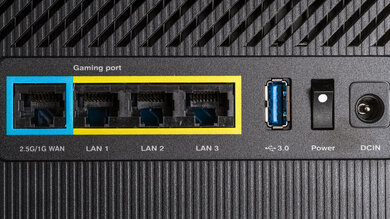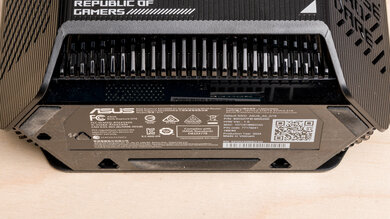The ASUS ROG Rapture GT6 is a tri-band Wi-Fi 6 gaming mesh router with a 2.4GHz band and two 5GHz bands. It has a gamer-y aesthetic, with the front panel donning a large ROG logo with RGB lighting that you can control with ASUS' Aura RGB engine. It supports the UNII-4 spectrum, or the 5.9GHz band, which ASUS advertises to improve the wireless backhaul performance between the access points. It also supports multi-gigabit wired networking with a 2.5Gbps WAN port and LAN ports that support link aggregation to combine for faster speeds.
It's available in Black or Moonlight White. We bought a two-pack and tested it in mesh mode.
Note: We've removed the Wi-Fi coverage tests and are exploring better ways to convey the results that will be more helpful to users.
Our Verdict
The ASUS ROG Rapture GT6 is a very good router for use in an apartment, condo, or smaller home. It has great average speeds and coverage across a single floor and is suitable for downloading large files quickly and handling multiple devices streaming 4k HDR content at the same time. That said, since it's a Wi-Fi 6 router, it doesn't have a faster 6GHz band that your newer Wi-Fi 6E and 7 devices can take advantage of.
-
Very good speeds.
-
Aggressive design is not for everyone.
-
Newer Wi-Fi 6E and 7 devices can't reach their full speeds on this Wi-Fi 6 router.
The ASUS ROG Rapture GT6 is very good if you live in a multi-level home. It delivers consistently good speeds and range that's suitable for most high-bandwidth activities like downloading large files quickly and streaming high-bitrate content throughout your home. Since it's a mesh network, you have flexibility in placing the satellite node to improve your network's coverage where you need it the most. That said, since it's a Wi-Fi 6 router, it doesn't have a faster 6GHz band that your newer Wi-Fi 6E and 7 devices can take advantage of.
-
Very good speeds.
-
Very good range.
-
Can add additional mesh access points to improve range.
-
Aggressive design is not for everyone.
-
Newer Wi-Fi 6E and 7 devices can't reach their full speeds on this Wi-Fi 6 router.
The ASUS GT6 delivers good speeds that are suitable for an internet connection of up to 700 Mbps.
-
Very good speeds.
-
Newer Wi-Fi 6E and 7 devices can't reach their full speeds on this Wi-Fi 6 router.
The ASUS ROG Rapture GT6 has a very good range. It's a mesh router that uses satellite units to maintain consistent speeds over long distances.
-
Very good range.
-
Can add additional mesh access points to improve range.
Changelog
- Updated May 01, 2025: We've converted this review to Test Bench 0.8.1. This includes a new test result for our Test Configuration box.
- Updated Dec 09, 2024: Review published.
- Updated Dec 02, 2024: Early access published.
- Updated Nov 28, 2024: Our testers have started testing this product.
- Updated Nov 21, 2024: The product has arrived in our lab, and our testers will start evaluating it soon.
Check Price
Differences Between Sizes And Variants
This router is available in Black or Moonlight White in a one or two-pack. We bought and tested a Black two-pack, and you can see our unit's label here.
Compared To Other Routers
The ASUS ROG Rapture GT6 is a Wi-Fi 6 gaming mesh router. While it delivers very good speed and range performance overall, it lags behind many cheaper and similarly priced options like the TP-Link Deco X5000, The ASUS ZenWiFi XT9, and the AmpliFi Alien. That said, it has many extra features than those options, like the ability to operate its backhaul in the UNII-4 spectrum for better signal and more granular control like game device optimization and game packet prioritization, so if you're a tinkerer, this mesh system is a great choice.
If you're looking for more options, check out our recommendations for the best Wi-Fi routers, the best mesh Wi-Fi systems, and the best Wi-Fi 6 routers.
The ASUS ZenWiFi XT9 performs better than the ASUS ROG Rapture GT6. It's faster when you're up close and has better range, despite both being Wi-Fi 6 mesh systems with a 2.4GHz band and two 5GHz bands. The XT9 has a sleek exterior design, while the GT6 has aggressive gamer styling that may not be for everyone.
The TP-Link Archer BE550 is faster than the ASUS ROG Rapture GT6. It's a Wi-Fi 7 standalone router, while the ASUS is a Wi-Fi 6 mesh router. However, since the TP-Link is compatible with EasyMesh, you can also add compatible access points for better range. The ASUS has an aggressive gamer design with RGB lighting, while the TP-Link has a more conventional design.
The ASUS ZenWiFi ET9 performs better than the ASUS ROG Rapture GT6. It's faster when you're up close and has better range. It's also Wi-Fi 6E with a 2.4GHz, a 5GHz, and a 6 GHz band, while the GT6 is Wi-Fi 6 with a 2.4GHz band and two 5GHz bands. The ET9 has a sleek exterior design, while the ASUS has aggressive gamer styling that may not be for everyone.
The ASUS ROG RAPTURE GT6 and the eero Pro 6 are tri-band Wi-Fi 6 mesh systems with a 2.4GHz band and two 5GHz bands. They have a very similar range, but the eero is slightly faster up close. The ASUS has more network ports, a USB port, and many more configuration options, but it has a very aggressive, gamer-y design that may not fit into your living space. The eero router, on the other hand, is more 'set it and forget it' as it has far fewer settings you can play with. It's the better pick for more casual users, while the ASUS is better for enthusiasts.
Test Results
This router's USB port supports USB 3.2 Gen 1 data transfer speed of up to 5Gbps.
We tested this router in dual mesh mode.
We tested this router in dual mesh mode.
The router didn't use DFS channels during our testing, but this might be because we purchased it from a Canadian retailer and tested it in Canada. The FCC filings indicate that it's authorized to operate on DFS-only channels in the U.S. If you're in the U.S. and have this router, let us know in the comments if it uses DFS channels.
Comments
ASUS ROG Rapture GT6: Main Discussion
Let us know why you want us to review the product here, or encourage others to vote for this product.
Update: We’ve converted this review to Test Bench 0.8.1. This includes a new test result for our Test Configuration box.
- 21010
Hi This is one of the mesh systems that I am considering purchasing. Will there be a Wifi-Coverage section? It seems that your recent router reviews have omitted that section. Its a shame because i find it very useful! Good review though
Hi,
Only the products at launch have the wifi coverage maps. This was the initial test we designed but the results obtained did not reflect the product performance properly or the big benefits of mesh systems. This is why we designed another test afterwards.
This is why you won’t see those in new reviews since we don’t have access to that building anymore. We’re not closing the door forever on coverage maps but we need to do additional research if we can make it a valuable test for you and others alike.
I am taking a note that you would like to see them since they were helpful so that will help us prioritize our efforts for future router tests.
Thanks and let me know if you have additional questions.
- 21010
Hi
This is one of the mesh systems that I am considering purchasing. Will there be a Wifi-Coverage section? It seems that your recent router reviews have omitted that section. Its a shame because i find it very useful! Good review though
The full review has been posted here. Let us know what you think!












